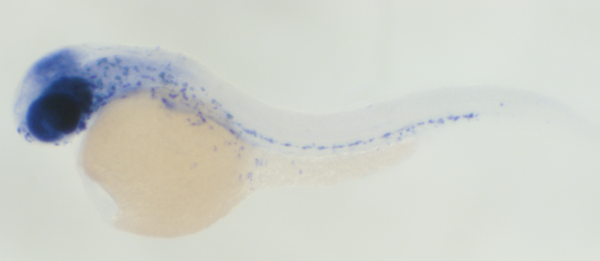Zebrafish Help Researchers Explore Alternatives to Bone Marrow Donation
UC San Diego researchers discover new role for epidermal growth factor receptor in blood stem cell development, a crucial key to being able to generate them in the laboratory
Published Date
By:
- Heather Buschman, PhD
Share This:
Article Content
Blood diseases such as leukemia and lymphoma are currently treated with bone marrow transplants — a transfer of blood stem cells from a healthy person to a patient in need. But the demand for patient-matched blood stem cells far exceeds their availability, and many patients go without. To bypass the need for donations, University of California San Diego School of Medicine researchers are using zebrafish and human cells to determine how to grow blood stem cells in a laboratory dish.
Whether it’s humans or zebrafish, a major player driving embryonic and blood cell development is the Wnt family of molecules. These molecules tell cells what to do by docking on Frizzled receptors, which sit on cell surfaces like antennae.
In their latest study, published May 20, 2019 by Nature Cell Biology, the team was surprised to discover that when one particular Wnt signaling molecule, Wnt9a, is received by blood stem cells, three different molecules are involved. Scientist had previously thought there were only two.

Zebrafish with blood cells shown as purple dots stretching the length of its body.
That third — and, it turns out, crucial — factor is the epidermal growth factor receptor, or EGFR. This finding may help advance the development of blood stem cells in the laboratory.
“Previous attempts to develop blood stem cells in a laboratory dish have failed, and that may be in part because they didn’t take the interaction between EGFR and Wnt into account,” said first author Stephanie Grainger, PhD, assistant project scientist at UC San Diego School of Medicine.
Researchers commonly use zebrafish — a pet shop staple — to study how blood stem cells develop in a normal organism. Zebrafish are an ideal model for this because they use the same mechanisms to make blood stem cells that humans do, but they are translucent as they develop. That means researchers can watch their blood stem cells arise in real time, and test how genetic modifications affect them.
According to the study, blood stem cell development works like this: The Wnt9a molecule touches down on a Frizzled receptor on the outer surface of a blood stem cell (Fzd9b, to be exact). At the same time, Wnt9a also brings EGFR into the mix from the outside of the cell, bringing Fzd9b and EGFR closer together. Then, inside the cell, EGFR tags Fzd9b’s inner tail with a chemical, a phosphate group. This last step triggers a cascade of cellular events necessary to turn a stem cell into a blood cell.
The researchers said identifying EGFR in this context was also exciting because many cancer therapies work by targeting this receptor.
“Our findings raise the possibility that such treatments will impact Wnt signaling,” said Karl Willert, PhD, associate professor at UC San Diego School of Medicine and faculty member in the Sanford Consortium for Regenerative Medicine. “We currently don’t know how EGFR inhibitors will impact the biology of blood stem cells, and future studies will certainly have to take these interactions into account.” Willert was co-senior author of the study with David Traver, PhD, professor at UC San Diego School of Medicine and Division of Biological Sciences.
Now that the team has determined how blood stem cells receive this Wnt signal at the cell surface, they will focus on unraveling how the cells relay and process the signal. Then they can start thinking about ways to trick the cells into thinking they have received this cue, even if they have not. That technique would better enable researchers to generate human blood stem cells in the laboratory — and perhaps one day use off-the-shelf blood stem cells, instead of bone marrow transplants, to treat patients with blood diseases.
Cancer cells often hijack these same developmental pathways to grow and form tumors. Grainger said learning how cells communicate with each other through Wnt, Frizzled and EGFR might provide a new approach to treating malignancies where these signals are out of control.
“This is a great example of how working in one area of biology can have a huge impact on a seemingly unrelated process,” said Willert, who is also director of the Human Embryonic Stem Cell Core Facility at UC San Diego School of Medicine. “In this case, we were studying Wnt’s role in blood development and we landed smack in the middle of the EGFR-cancer field.”
Co-authors of the study include: Nicole Nguyen, Jenna Richter, Jordan Setayesh, Brianna Lonquich, Chet Huan Oon, Jacob M. Wozniak, Rocio Barahona, Jack Houston, Marvic Carrillo-Terrazas, David Gonzalez, UC San Diego; Caramai N. Kamei, Massachusetts General Hospital; and Iain A. Drummond, Massachusetts General Hospital and Harvard Medical School.
This research was funded, in part, by National Institutes of Health (grants K99HL133458, R01HL135205, R01GM110304, T32 GM007752, UH2-3DK107372), California Institute for Regenerative Medicine (grants RB4-06158, TG2-01154, FA1-00607), UC San Diego Stem Cell Program, American Heart Association (grants 14POST18340021, 16PRE27340012), and Leukemia and Lymphoma Society (grants 5431-15, 1657-13).
Share This:
You May Also Like
Stay in the Know
Keep up with all the latest from UC San Diego. Subscribe to the newsletter today.



